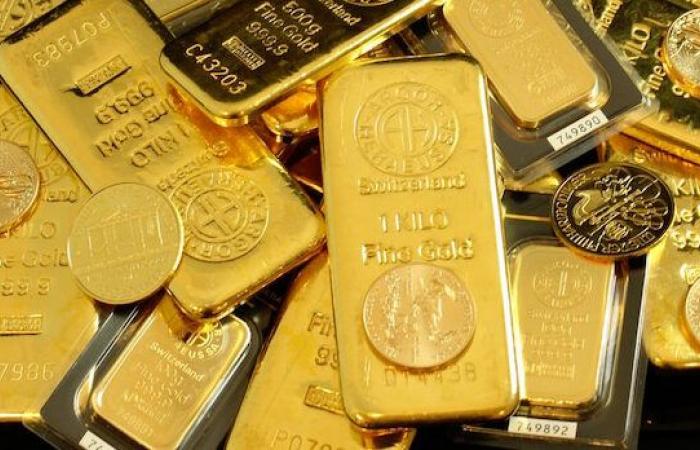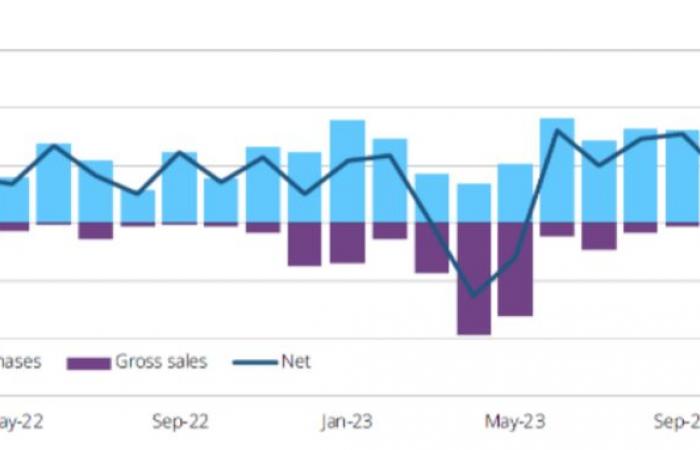As it was then, gold fever returns to the markets, albeit 175 years later. The yellow metal reached a new all-time highabove 2,440 dollars per ounce on Friday, which means an increase, so far in 2024, close to 15% and 18% in one year, despite, after the attack in the Middle East, having lost profits, but insignificant magnitude.
In 1849, news of the sensational discovery of gold northeast of San Francisco triggered a unbridled rush for the precious metal, causing several waves of people to arrive on the west coast of the USA willing to do anything to get rich. Today, the argument is different, and has a lot to do with the accumulation of reserves by central banksto which is added the investment interest in an asset considered a refuge in the face of increased geopolitical risk, given the characteristic of preserving value over time, even in times of high inflation.
Amid tensions in the Middle East, gold continued to rise, despite, throughout the stock exchange’s first day following the launch of 300 missiles and drones by Iran towards Israel, and according to Citi, “the recent rise in gold has been favored by geopolitical tension and coincides with record levels of the stock market index”.
What’s behind the gold movement?
Many question what is behind this rise. There are several factors: experts consider that it has to do with central bank purchaseswhile others point to a hedge against inflation and current geopolitical risks.
Gold’s recent movement can be, in part, explained by the dollar, geopolitical risk and momentum
In this sense, according to a report by the World Gold Council (WGC in its acronym in English), theCentral banks added 39 tons to world gold reserves in January, which corresponds to eight consecutive months of buying the metal. Among the central banks that stand out the most are:
- Central Bank of Türkiyewhich increased official detentions by 12 tons, increasing total holdings for 552 tonsjust 6% less than the historic maximum recorded in February 2023, of 587 tons.
- People’s Bank of China, with an increase of 12 tons, the 15th consecutive month of increases and with a total gold holding which rises to 2,245 tonsalmost 300 tons more than at the end of October 2022, when it decided to resume gold purchases.
- Reserve Bank of Indiaadding almost nine tons, being the first monthly increase in gold since October 2023 and the largest since July 2022, accumulating arrests of 812 tons.
The same report also comments that sales recorded in January were limited, although the most notable was that of the Central Bank of Russiawhose gold reserves decreased by three tons, a pattern that has been in force since 2021 and which, it seems, is related to the country’s coin minting program.
Central banks have been buying gold for eight consecutive months
Source: IMF IFS, respective central banks, World Gold Council
However, as the report comments, in the future, a sustained increase in the price of gold could trigger new investment flowsalthough it remains sensitive to the volatility of short-term bond yields.
Estimates point to levels of 2,350 dollars
For Luc Luyet, economist at Pictet Wealth Management, “Official gold demand has soared since Western sanctions on Russian currency reserves in early 2022, although central bank demand, a portion of official demand, has declined recently.”
Furthermore, he considers gold attractive in the long term, and official demand is likely to remain strong, as Western sanctions on Russian currency reserves promote an increase in these central bank allocations, as well as due to the beginning of the Federal Reserve’s monetary easing cycle, growing fiscal deficits in the US, concerns about Chinese assets and greater structural geopolitical uncertainties. The economist points out that its one-year forecast is for the price to be $2,350 per ounce.
On the other hand, Goldman Sachs had already increased its gold price forecast to $2,700 for the end of 2024 from the previously set target of $2,300, as considers that the yellow metal is in an unshakable upward market. However, it considers that a peaceful resolution of the current problems in the Middle East and Ukraine and a stabilization of the risk of sanctions could lead to a reduction in the gold purchasing programs of the main central banks.
In light of these geopolitical developments, Neuberger Berman Commodities fund manager Hakan Kaya warns that it is clearly overweight geopolitically sensitive raw materials, such as oil, aluminum, nickel, copper and gold. The expert comments: “Not only as a coverage strategy against inflationary pressures as well as how vital safeguard against supply fragilities which could harm traditional assets, such as bonds and shares.”







